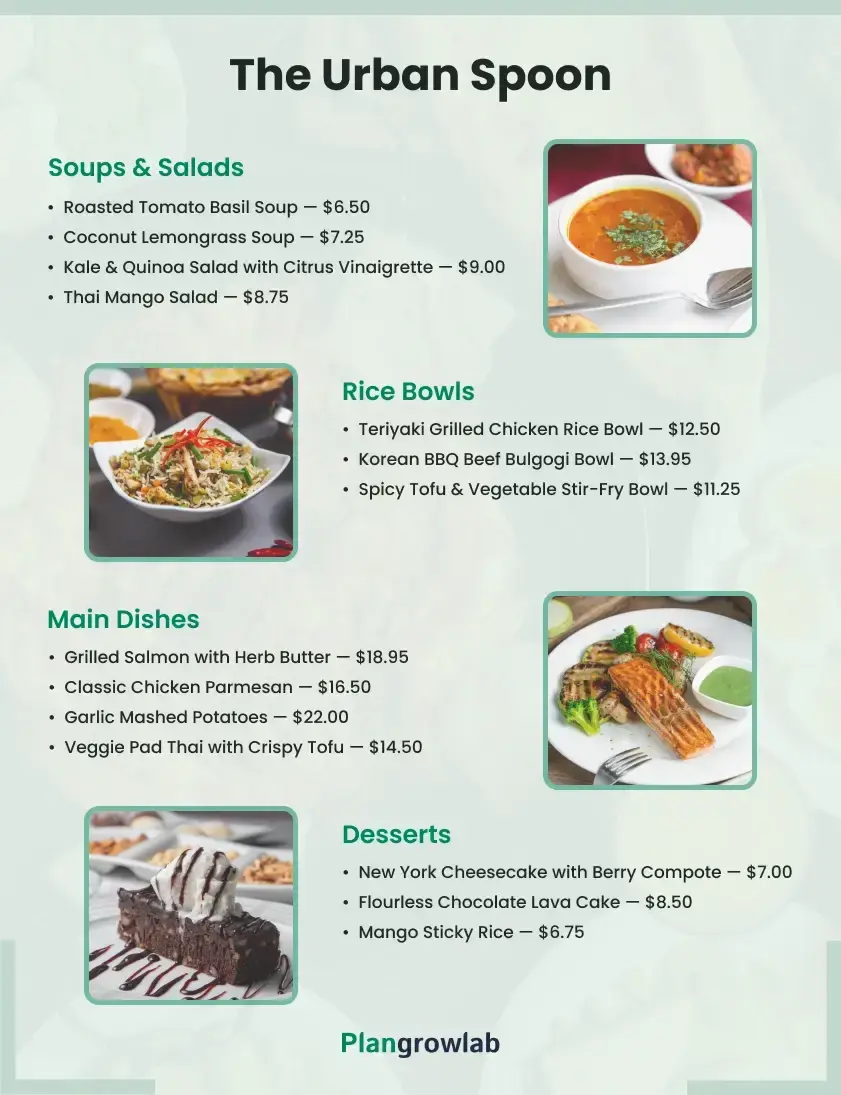Starting and running a successful restaurant can be the most exciting and rewarding venture you might take on.
But let’s face it—creating a solid business plan often feels like a huge task (i.e., a mountain to climb). Even Laura Adams, the owner of Carrousel Restaurant Group Inc., felt the same.
I recently had an opportunity to talk to Laura about how she put together her business plan and overcame the challenges along the way.
From that conversation, I’ve compiled this detailed guide that helps you develop a restaurant business plan that makes a real difference—just like Laura did. Let’s get started!
What is a restaurant business plan?
A restaurant business plan is a strategic document that serves as a detailed roadmap for starting and growing your own restaurant.
Basically, it highlights your restaurant’s proposed concept, vision, core values, target market analysis, competitors, sample menu, marketing plan, initial funding requirements, and financial projections—to name a few items.
All in all, it’s an important tool to guide your entrepreneurial journey and make it a success.
How to write a restaurant business plan?
Writing a comprehensive restaurant business plan requires careful attention to different key sections and elements that entirely define your restaurant’s mission, goals, and strategies. Here’s a guide to cover all the aspects:
1. Executive summary
An executive summary is basically the opening section of your restaurant business plan.
It provides a quick, concise overview of your restaurant, explaining what makes it stand out and how it will succeed.
Though it’s an introductory part, writing your executive would be easier at the last once all the key sections are ready. Why? Because it summarizes all the essential elements mentioned in the rest of your plan.
Here’s what to include in your plan summary:
- Restaurant name and location
- Type of restaurant you own (fine dining, casual, or a food truck)
- Target market
- Unique selling points
- Marketing efforts
- Financial projections
Simply put, your executive summary acts like an elevator pitch that quickly captures the readers’ attention and makes them learn more about your business. So, ensure it’s short, simple, and compelling.
“Putting together the executive summary for my restaurant’s business plan, the hardest part was figuring out our unique selling point. With so many dining options around here, I knew we had to stand out.
Thus, I had to figure out how to make our concept stand out without sounding too much like the usual ‘we serve great food’ line.
Even, I focused on our commitment to local ingredients and seasonal dishes, which matter to our target customers. That angle helped ground the summary in a way that showed how we’d connect with the community."—Laura Adams
2. Business overview
This section is where you’ll explain your restaurant concept, vision, business model, and brand in more detail.
It’s your chance to give readers a clear snapshot of what your restaurant business is all about. Hence, try to keep it clear and to the point but meaningful.
While drafting your business overview section, flesh out all the following details:
- Restaurant concept
- Vision and mission statement
- Legal structure (a sole proprietorship, partnership, LLC, or corporation)
- Business owner or partner
- Background history
- Short-term goals and long-term objectives
In short, this section sets a strong foundation for the rest of your plan and highlights what makes your restaurant unique.
“It was challenging for me to craft a mission statement that felt real, not just buzzwords about being ‘unique’ or ‘authentic.’
I wanted it to capture what we’re actually about—bringing fresh, local ingredients into a cozy space where people could feel at home.
After a lot of rewriting, I ended up focusing on our core goal: to offer a neighborhood spot with amazing seasonal dishes and a welcoming vibe that would draw people back."—Laura Adams
3. Sample menu and service offerings
Well, the sample menu is the core of any restaurant, highlighting what you’re going to offer and capturing the essence of your culinary approach.
So, focus on your unique items, signature dishes, and classic flavors that make your restaurant special. This will give readers a glimpse into your key offerings, pricing strategy, and how you’ll serve your customers.

Moreover, outline how customers will experience your restaurant. Explain your service style. Will it be table service, counter service, buffet-style, or takeout-focused?
If any, mention any unique service features, like digital ordering, meal customization, exclusive chef’s table experiences, etc.
Remember, your sample menu and service style must align with your overall restaurant concept and target audience.
“Creating a sample menu for Carrousel Restaurant turned out to be a real balancing act, especially in choosing signature dishes to set us apart."
I wanted options that felt true to our concept but would also connect with the LA crowd, who love food that’s healthy but also has a lot of flavor.
After testing out different dishes and getting feedback, I realized it’s better to focus on a few standout items. We ended up with a menu that felt curated and intentional instead of just packed with options."—Laura Adams
4. Market research and target customers
Next, it’s time to analyze the restaurant industry and market to better understand the external environment in which your business intends to operate.
Thorough market research helps you know your ideal customers, identify their specific needs, evaluate the demand for your restaurant, and map out your restaurant’s position in the chosen area.
To make this section more impactful, you’ll have to describe all the following components:
- Market size and growth forecast (statistics or research findings)
- Industry trends
- Location analysis
- Target market needs & preferences
- Regulatory compliance
If required, consider creating a well-defined ideal customer profile that adds credibility to your business plan. It even shows that you’re prepared to reach and serve the right audience.
“Defining the specific traits and preferences of our potential customers was a big task. Saying ‘food lovers’ wasn’t enough—I needed to get clear on their dining habits and what would actually make them choose our spot over others.
So, I spent some weekends hanging around other local restaurants, watching the types of people coming in, what they ordered, and how long they stayed.
I even struck up a few casual conversations to get a sense of what they liked or wished was different."—Laura Adams
5. Competitive analysis
While conducting your market analysis, identify the key competitors, i.e., other restaurants in your area.
Study what they’re doing well (strengths) and where they fall short (weaknesses). Also, compare your pricing and food offerings.
From that, explain how you’ll differentiate your restaurant or fill the gaps that competitors aren't meeting. This will give you a competitive edge in the market and help you position yourself effectively.
For instance, you might have a competitive advantage—a different price point, a unique menu, or a welcoming atmosphere—that sets you apart.
“If I could offer one tip for competitor research, I’d say really immerse yourself in what your direct competitors are doing.
Experience it like a customer and take notes on what could be better. It’s the best way to find where you can stand out and bring something fresh to the community."—Laura Adams
6. Marketing strategy
Your marketing strategy clearly outlines how you’ll promote your restaurant and bring in a loyal customer base.
This part showcases financial backers that you keep a solid plan to reach your target audience, generate excitement among them, encourage repeat business, and build your restaurant’s brand.
To plan this section, consider including all your marketing efforts as well as sales tactics, such as:
- Social media advertising
- Launch or grand opening marketing
- Brand positioning
- Partnerships with nearby businesses
- Planned promotions and special discounts
- Loyalty programs
All these strategies help you attract new clients and retain existing customers while tracking marketing budget and maximizing potential ROI.
“I knew we had a great concept for Carrousel Restaurant, but figuring out how to get the word out in a way that felt real was tough.
I thought about running ads everywhere but quickly realized that building relationships would go further.
That’s why I focused on social media and teaming up with local businesses. We started cross-promotions with a couple of popular nearby spots and even hosted small community events."—Laura Adams
7. Operations plan
The operations plan covers the day-to-day processes and logistic operations that keep your restaurant running smoothly.
A well-crafted operations plan reassures potential investors or stakeholders that you have a practical approach to managing everything from food preparation to staff scheduling, ensuring efficient operations and excellent customer service.
Here’s a list of operational intricacies that you must incorporate in this section:
- Staffing needs and training
- Daily operations (opening & closing procedures, food prep schedules)
- Suppliers and inventory management
- Customer service experience
- Restaurant design
Lastly, don’t forget to highlight your awareness of potential challenges and how you plan to address them.
Try to use simple, clear language to describe each operational area.
“First, I thought the operations plan would just be about organizing schedules, managing inventory, and making sure we had enough staff.
But there’s one big challenge—setting up an efficient system for peak hours, especially during the dinner rush.
I didn’t want the team scrambling or customers waiting too long, so we reworked the kitchen layout and created prep stations for high-demand items.
That way, when the rush hit, our team was ready, and service went a lot more smoothly."—Laura Adams
8. Management team
This section introduces the key players who will run your restaurant, highlighting you have a skilled, capable team ready to bring your vision to life.
As a restaurant owner, first, you have to share a bit about yourself, along with your roles and responsibilities.
Then, list down each core team member, such as the head chef, general manager, marketing lead, and other executive team members. Share their responsibilities, qualifications, experience, and skills that benefit you to grow your restaurant.
A strong management team section lets you build confidence in your restaurant’s potential for success.
“Being a smaller team, I wasn’t sure how to make it sound strong and structured in the business plan without stretching the truth.
But I focused on each person’s strengths—our head chef’s experience with seasonal menus, my background in restaurant management, and our front-of-house manager’s knack for creating a welcoming atmosphere.
Focusing on each person’s strengths really helped show that we’re small but effective, with the expertise to run a successful restaurant."—Laura Adams
9. Financial plan
Now, let’s dive into the numbers—the financial details that will define your restaurant’s path to profitability.
Typically, your restaurant financial plan is a detailed breakdown of your financial projections for the next few years. This will help you and potential investors evaluate your restaurant’s financial viability and sustainability.
There are a few critical financial statements and reports you should be sure to include:
- Income statement (profit and loss statement)
- Cash flow statement
- Balance sheet
- Break-even analysis
- Funding needs (if any)
Besides that, you should also estimate your restaurant’s startup costs, projected revenue, as well as operating expenses. Use simple charts and tables to make financial data easier to digest.
“When I was working on the financial plan, I thought I’d just jot down costs and sales estimates, but all the extra details—seasonal slowdowns, credit card fees, maintenance costs—quickly got overwhelming.
Hence, I ended up trying a financial forecasting tool, which was a game-changer.
I could plug in different scenarios, like what a slow month versus a busy one would look like, and the tool adjusted everything for me.
It made our cash flow projections way clearer and helped me take the guesswork out of planning."—Laura Adams
Download free restaurant business plan template
So, are you ready to craft your restaurant business plan, but confused about where to start? Not to worry; download our customizable restaurant business plan template in PDF to ease your process.
This investor-friendly business plan template comes with practical insights and examples to help you develop your very own restaurant business plan more efficiently. Just download it and modify it to fit your specific requirements.
Conclusion
After exploring this detailed guide and a free template, you’re now well-equipped to craft your own plan.
However, if you ever feel stuck or need expert-level guidance, consider talking to the best business plan consultants out there. They’ll help you fine-tune your business plans and make sure it impresses investors.
So, why wait? Make a call and plan for your new restaurant!
Frequently Asked Questions
What should be included in a restaurant business plan?
Consider including the following key components of in your restaurant business plan:
- Executive summary
- Business overview
- Restaurant industry and market research
- Competitive analysis
- Sample menu
- Sales and marketing plan
- Management structure
- Operational strategy
- Financial projections
Why is a market analysis important in a restaurant business plan?
Market analysis helps you get valuable insights into the target customers, their preferences, restaurant industry trends, as well as key competitors in your area.
What are the primary funding sources for opening a restaurant?
Explore these funding sources to open a restaurant:
- Small business or bank loans
- Independent restaurant investors
- Government grants
- Crowdfunding platforms like GoFundMe or Kickstarter
How do I project revenue for my restaurant business plan?
While projecting revenue for your restaurant business plan, follow these steps:
- Estimate daily customer traffic
- Calculate average customer spend
- Account for meal periods and peak times
- Reflect seasonal fluctuations
- Multiply and calculate monthly revenue
How often should I update my restaurant business plan?
It’s recommended to update your restaurant business plan regularly, at least once a year, or more often—whenever significant changes happen in your business environment.

